

LW59 Spring 2021LO. Experience: I’m a tree hugger. When I was very small, my grandfather used to wheel me in a pram through the local park on the way to the Royal Botanic Garden Edinburgh.

Looking up at the trees helped me get to sleep. So maybe I’ve always been on a wooden wavelength. I’ve spent all my adult life working with trees, and the past 14 years working at the RBGE as a curator. Recently, our fundraising team was looking for novel suggestions to raise money to help save the giant redwood avenue at our site in Benmore. Some of the staff suggested I do a sponsored tree huggathon. They knew I’d been a tree hugger since a very early age. Still, I wasn’t sure people would be interested enough in an old man hugging trees to donate money. My approach to the challenge was improvised. My tree hugging technique is based on a simple principle: making maximum contact. I was struck by how different the experience was with each tree.
Admittedly, there were a few raised eyebrows from passersby. As told to James Ware. How to Identify a Tree by Its Leaves, Flowers, or Bark. Trees come in various shapes and sizes but all have the same basic botanical parts and structure.

Each tree has a central column called a trunk. The bark-covered trunk supports a framework of branches and twigs known as the tree's crown. Branches, in turn, are covered in leaves and sometimes flowers. Tree Rings Reveal How Ancient Forests Were Managed. Clear-cutting a forest is relatively easy—just pick a tree and start chopping.

But there are benefits to more sophisticated forest management. One technique—which involves repeatedly harvesting smaller trees every 30 or so years but leaving an upper story of larger trees for longer periods (60, 90, or 120 years)—ensures a steady supply of both firewood and construction timber. To determine when this management practice first arose in Europe, researchers have analyzed oak construction timbers from historical buildings and archaeological sites dating from the 4th to 21st centuries.
They spotted a characteristic tree ring pattern indicative of this technique in timber dating back to the 6th century. Plant of the Month: Agarwood. Absolutely Barking! So I’m looking at the bark of a tree – can I say why the bark like it is?

Is it possible to say what has determined why this particular tree has this particular pattern. Well, it’s almost certainly, not possible, to account for every minute detail of the bark, some of it will probably be entirely random. This won’t be a complete list of factors (and some of these factors may overlap, amount to same thing as other factors, or indeed not be relevant) RHS Lindley Library – Digital collections. Varieties under threat From its earliest years, the RHS cultivated a rich apple tree collection.
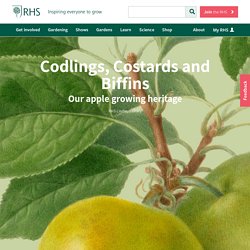
The substantial orchard at its first official garden at Chiswick (1823–1903), was a living reference library for the identification of new fruit and the reliable growth of new apple trees. Robert Thompson, the gardener in charge, painstakingly described each variety in his dedicated apple books. Did American Chestnut Really Dominate the Eastern Forest? - Arnold Arboretum. Before the turn of the century, the eastern half of the United States was dominated by the American chestnut.”
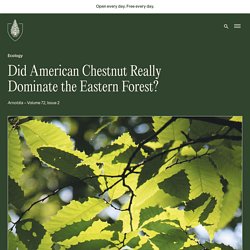
American Chestnut Research and Restoration Project, SUNY College of Environmental Science and Forestry (2013) Along with the bison and the passenger pigeon, the American chestnut forms an iconic triumvirate of the grandeur of the American wilderness and the devastation that human activity wrought upon it over the past three centuries.
Just as the bison was the preeminent large mammal on the continent and the passenger pigeon the most abundant bird, so is chestnut often described as having dominated the eastern forest (or across its geographic range) prior to its destruction by an introduced Asian chestnut blight. By all accounts chestnut was a magnificent and invaluable tree. These Five “Witness Trees” Were Present At Key Moments In America’s History. A witness tree begins its life like any other tree.
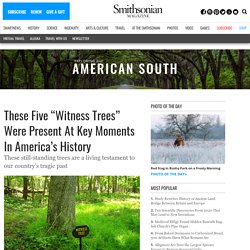
It sprouts. It grows. And then it’s thrust into the spotlight, playing an involuntary part in a significant historic event. Often, that event is a devastating, landscape-scarring battle or other tragic moment. Once Civil War soldiers march on to their next battle, say, or a country turns its attention to healing after a terrorist attack, a witness tree remains as a biologically tenacious symbol of the past.
Witness trees have been known to hide bullets they’ve absorbed beneath new layers of wood and bark, and they heal other visible scars over time. Travelers, history lovers, some park rangers and others have embraced these exceptional trees as important, living connections to our past. Tree root identification saves ancient caves and the forest above them. Ancient burial caves dating to approximately 1800 years ago are under threat in Galilee, Israel.
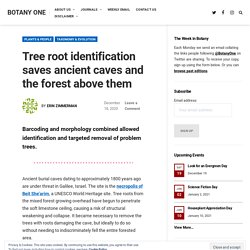
The site is the necropolis of Beit She’arim, a UNESCO World Heritage site. Tree roots from the mixed forest growing overhead have begun to penetrate the soft limestone ceiling, causing a risk of structural weakening and collapse. It became necessary to remove the trees with roots damaging the cave, but ideally to do so without needing to indiscriminately fell the entire forested area. The Social Life of Forests. The Social Life of Forests By Ferris Jabr Photographs by Brendan George Ko As a child, Suzanne Simard often roamed Canada’s old-growth forests with her siblings, building forts from fallen branches, foraging mushrooms and huckleberries and occasionally eating handfuls of dirt (she liked the taste).

Her grandfather and uncles, meanwhile, worked nearby as horse loggers, using low-impact methods to selectively harvest cedar, Douglas fir and white pine. They took so few trees that Simard never noticed much of a difference. The forest seemed ageless and infinite, pillared with conifers, jeweled with raindrops and brimming with ferns and fairy bells. Gavin Van Horn, Breathing Trees - The Learned Pig. Inhale Slash of sunlight, tempered by voile drapes of moss, dripping and curling filamentous fingers around dark branches.
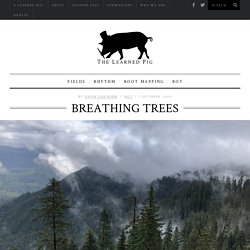
The woods are shaggy with green and, in this autumnal light, aglow. My mind is also rank with vegetation. Andrew Groover: Evolution and development of wood formation in forest trees. The crowning glory of Kew. Palace of Palms: Tropical dreams and the making of Kew by Kate Teltscher 2020. Picador. The UK’s Royal Botanic Gardens at Kew near London are famed as much for the buildings and grounds, as the ground-breaking, world-leading research into plants that is carried out there. And Kew’s most iconic building is undoubtedly the Palm House, which in many respects is the focal point of the Gardens. Kew’s buildings and plants are masterfully combined by Kate Teltscher in Palace of Palms which places the Palm House and its precious plant contents centre-stage. Satellites could soon map every tree on Earth.
Terrestrial ecosystems are defined in large part by their woody plants. Grasslands, shrublands, savannahs, woodlands and forests represent a series of gradations in tree and shrub density, from ecosystems with low-density, low-stature woody plants to those with taller trees and overlapping canopies. Accurate information on the woody-vegetation structure of ecosystems is, therefore, fundamental to our understanding of global-scale ecology, biogeography and the biogeochemical cycles of carbon, water and other nutrients. Writing in Nature, Brandt et al.1 report their analysis of a massive database of high-resolution satellite images covering more than 1.3 million square kilometres of the western Sahara and Sahel regions of West Africa. Urban Trees, Whether Native Or Introduced Species, Provide The Same Ecological And Social Services. Katie Holten on Turning Words and Paragraphs into Whole Forests. Katie Holten’s tree project is the best example I’ve encountered in recent memory of a simple idea that carries the weight of something much more complex.
Holten, an Irish-born visual artist based in New York City, has created an alphabet of trees that she uses to translate text into trees. About Trees, the resultant anthology, is a provocative examination on the nature of language and our relationship with the natural world as we enter a new age, what many geologists are calling the Anthropocene. As the breakdown of the natural world coincides more and more with that of the human world, and our interdependence becomes more apparent, such explorations grow more urgent. This urgency is one of the guiding impulses behind the new Parapoetics series published by Broken Dimanche Press, of which About Trees is the first title. I interviewed Katie in September 2015, just as About Trees was published in a limited run.
Gavin Van Horn, Breathing Trees - The Learned Pig. Inhale Slash of sunlight, tempered by voile drapes of moss, dripping and curling filamentous fingers around dark branches. The woods are shaggy with green and, in this autumnal light, aglow. My mind is also rank with vegetation. Filled up with verdant ideas I brought to these woods about the porous boundaries between plant and animal kingdoms; latticed with thoughts about our kinship and dependence on these beings who create energy from sunlight; saturated with the emerging research on the many ways plants communicate with one other, with fungi, with insects, and with us.
I am thinking of a recent series of court rulings—in India, Nepal, Australia, and Columbia—affirming personhood for nonhuman entities. My back and shoulders pressed into a Douglas-fir trunk, I wonder: Can individual trees be considered nonhuman persons? My first disorientations in this forest—the H.J. Aspirin: Turn-of-the-Century Miracle Drug. Headache? View from the sky sees new hope for restoring degraded forests. Decoding Palms: Deciphering Plant Mysteries One Publication at a Time. Budding History: On Nationalism and Cherry Blossoms. Why Some Buddhist Monks Ordain Trees. All over the world, trees are a symbol of natural ecology that environmentalists rally to protect. In Thailand, anthropologist Nicola Tannenbaum writes, they have a unique method of doing that: symbolically ordaining trees as monks. Tannenbaum writes that Buddhist monks have long been involved in social movements and development efforts in Thailand.
In the early 1980s, they were part of missionary and development programs, supporting the national goals of education, development, and modernization. Experience the sound of forests from around the world with the first ever forest soundmap! Head to Nuneham Courtenay to listen to the sound of the woodlands at the Arboretum. #SoundOfTheForest□ Why Learning the Names of Trees Is Good for You. Eleven Ways of Smelling a Tree. The Chart That Measures Tall Trees Against Architectural Wonders.
Eduard Mielck was a big fan of enormous plants. Map of all the trees and forests.
A botanical wild cat. The Scottish native wild apple (Malus sylvestris), like the Scottish wild cat, could be regarded as being under threat from interbreeding with its domesticated counterpart. Tree Planting — A user’s guide for comparing tree for tree - Nature4Climate : Nature4Climate. Secrets of '1,000-year-old trees' unlocked. Image copyright Getty Images. An evolutionary and cultural biography of ginkgo - Crane - 2019. Helen Mirren voices new plant health animation. The Past and the Future of the Earth’s Oldest Trees.
Wood From Old Log Cabins Reveals Secrets Of Trees, Forests, Population And People. LW54Winter2019 FINAL. Tall tree perspective. Evolutionary history of oaks. Amazonian tree with human-sized leaves finally gets ID’d as new species. Measuring Forest Biodiversity Status and Changes Globally. The oldest olive-tree in the world, with a solid 24m trunk, is located in my home town-Ierapetra. It is almost 4,000 years old (1900-1800 BC). Where this olive tree is found, there is a Minoan olive mill, the most important one in the Aegean according to. BBC Radio 4 - Natural Histories, Oak - 12 mighty facts about oak trees. Oak symbolism in the light of genomics - Leroy - Resequencing 545 ginkgo genomes across the world reveals the evolutionary history of the living fossil. Exploring the origins of the apple. A Day in the Life of a Tree.
Evergreen deciduous oaks a mixed bag. Afforestation in grasslands will destroy ecosystems and livelihoods – it won’t solve climate change. The benefits of trees for livable and sustainable communities - Turner‐Skoff - The Miyawaki Method: A Better Way to Build Forests? The Trees Might Save Us Yet. City of trees. Global Tree Assessment. Intersecting urban forestry and botanical gardens to address big challenges for healthier trees, people, and cities - Cavender - - PLANTS, PEOPLE, PLANET - Wiley Online Library.
Trees. Reforesting an area the size of the US needed to help avert climate breakdown, say researchers – are they right? How Tree Planting Could Save Us All From Our Own Climate Change Mess. Tree planting 'has mind-blowing potential' to tackle climate crisis. Max Planck Institute for the Science of Human History. Mapping the land by the predominant tree genus is genius! How Longleaf Pines Helped Build the U.S. How Trees Can Save Lakes From Algae Blooms. The Trees That Sail to Sea. Tracking down one of the most elusive species on the planet. Complete world map of tree diversity. Darwin Tree of Life sets down roots.
How much can forests fight climate change? Plant of the Month: The Dragon Tree. The Most Wonderful Smelling Time of the Year. 2015 72 3 bark from abstract art to aspirin. When a Cultivated Tree Goes Rogue. Trees cover more area now than 35 years ago. Plant Names Tell Their Stories: Acer pensylvanicum is Full of Local History. The world’s first trees grew by splitting their guts. Atlasobscura. Genetic Resources Unit. Documenting Trees. University of Manchester Tree Trail. Countryfile go extreme tree hunting. Take part in the Ancient Tree Hunt with the Woodland Trust. Ugandan Barkcloth, a Fabric Made From Fig Trees. What’s Killing European Trees? The importance of scattered trees for biodiversity conservation: A global meta‐analysis - Prevedello - 2018 - Journal of Applied Ecology - Wiley Online Library. Treeconomics. MIT Senseable City Lab. 18 Of The Most Magnificent Trees in the World.
Why do the world’s largest trees have some of the smallest leaves? Worldwide hemisphere-dependent lean in Cook pines. Remembering the Elm – Stories from the Museum Floor. #AdventBotany Day 5: Walnuts. Japanese Experiment That Took Half A Century Ended In Amazing Tree ‘Crop Circles’ Funding awarded to innovative data projects. Wood wide web: Trees' social networks are mapped.